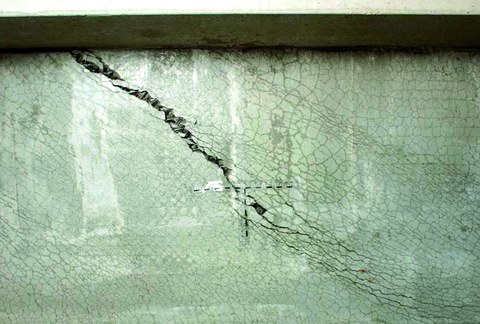Untersuchungen zur Querkraftverstärkung mit TRC unter nicht vorwiegend ruhender Beanspruchung
Inhaltsverzeichnis
Projektdaten
|
Titel | Title |
Bericht aus dem Jahrbuch 2012
Textilbeton – alternative Verstärkung bei zyklischer Beanspruchung?

Schadensbild nach dem Versagen
In einer Machbarkeitsstudie wurden zehn großformatige Plattenbalken bezüglich ihrer Querkrafttragfähigkeit unter vorwiegend ruhender und nicht vorwiegend ruhender Belastung geprüft. Ziel war es herauszufinden, inwiefern sich eine zyklische Beanspruchung auf die Tragfähigkeit des Stahlbetonbalkens, einer Textilbetonverstärkungsschicht oder den Verbund zwischen Altbauteil und Verstärkung auswirkt. Dazu wurde eine Schwellbelastung mit zwei Mio. Lastwechseln aufgebracht. Der Dauerlastanteil betrug 80 %, die Schwingbreite 30 % des Gebrauchslastniveaus.
Alle zyklisch beanspruchten Bauteile überstanden die vorgesehenen zwei Millionen Lastwechsel. Während der Schwellbelastung wurde das Rissbild auf den Stegseitenflächen regelmäßig auf Veränderungen geprüft und fotografisch dokumentiert. Während der Beanspruchung entstand ein feiner Riss zwischen dem oberen Stegbereich und der Unterseite der Platte, welcher sich gegen Ende der Prüfung zum zum Versagen führenden Schubriss ausbildete.
Durch die textile Verstärkung sowie den höheren Bewehrungsgrad der Plattenbalken konnte die Dehnsteifigkeit des Steges gesteigert werden, was zu einer höheren Querkrafttragfähigkeit führte. Bei der Prüfung der Resttragfähigkeit erreichten die vorher zyklisch beanspruchten Bauteile sogar höhere Tragfähigkeiten als die statisch geprüfte Referenz, was nach derzeitigem Kenntnisstand an der höheren Betonfestigkeit zum Zeitpunkt der Prüfung lag. Das Versagen zeigte sich durch einen deutlich sichtbaren Schubriss. Die Mittendurchbiegungen waren zum Zeitpunkt des Versagens bei allen Probekörpern unabhängig von der vorangegangenen Belastung in etwa gleich groß. Auch die Schwellbelastung wirkte sich offenbar nicht negativ aus.
Die Versagenslasten aus den Tests wurden anschließend mit berechneten Werten verglichen. Für die Prognosen wurde ein erweitertes Fachwerkmodell ähnlich dem der Stahlbügelbewehrung angesetzt. Alle Versuchswerte wurden im Modell unterschätzt, wobei zwischen Rechnung und Prüfung offenbar eine systematische Abweichung vorliegt. Diese Differenz ist für alle Balken nahezu gleich. Es wurde gezeigt, dass die Traglaststeigerung, die die Textilbetonschicht bewirkt, sehr gut idealisiert wird. Die Abweichungen sind wahrscheinlich eher auf eine unberücksichtigte Tragwirkung zurückzuführen, die mit den üblichen, auf parallelgurtigen Fachwerken beruhenden Modellen nicht erfasst wird.
